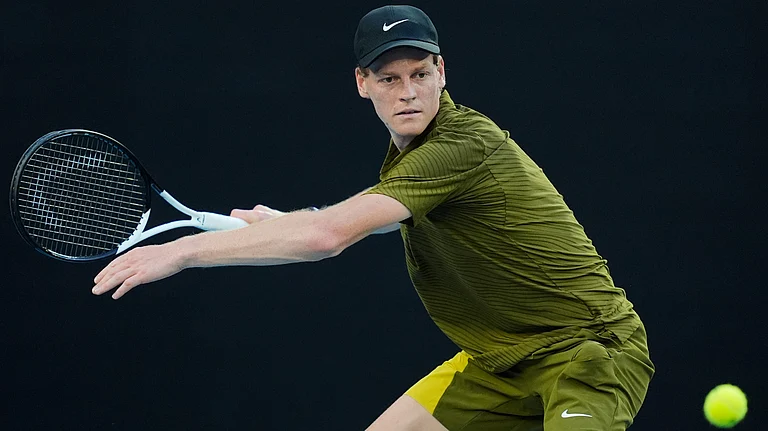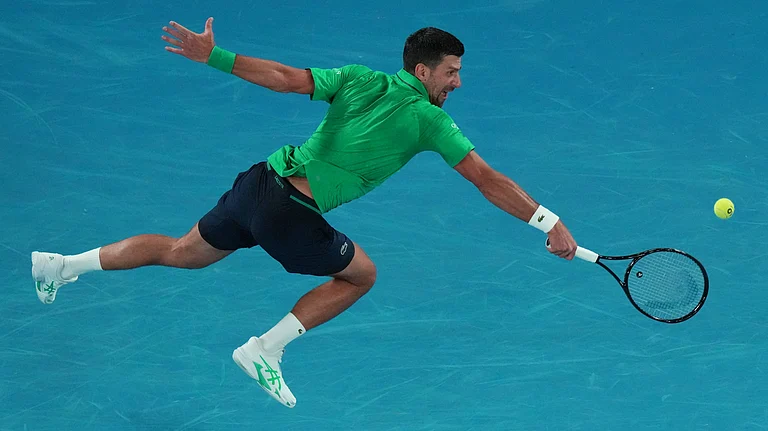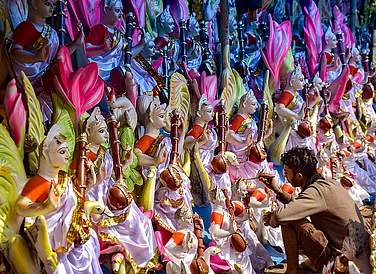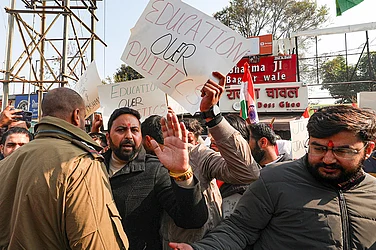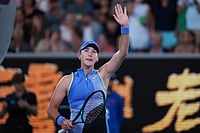Is my language clumsy?
Does the sound of my verse disturb you?
Syncopating to an unnatural rhythm:
Jabbering and gurgling like
Muddy waters convulsing over rough rocks
When a new stream is born.
____Pidgin by T. Keditsu
For the first time in the 50-year-long history of the New Delhi World Book Fair (NDWBF), Adivasi publishers have found a space dedicated to a stall for Adivasi literature. Featuring the works of Adivasi writers and publishers from across India, the Adivasi Indigenous Book Akhra invitation greets you with ‘Johar’ and reads “We Were, We Are, We Will Be.”
Initiated by Jharkhand-based Pyara Karketta foundation (PKF), most of the Adivasi-owned publishing houses have come together to showcase their works. Ashwini Kumar Pankaj, an Adivasi scholar and the founder of PKF tells Outlook, “In the 50 years, nobody thought of the Adivasi publishers. Nobody asked where are Adivasis and their works?”
However, even after PKF’s efforts under the guidance of Adivasi novelist and renowned author Vandana Tete, they could hardly find Adivasi-run publishing houses. “It is only in Jharkhand and Nagaland where you can find proper Adivasi publishing houses. In other states there are very few. Still, we could manage to get 7-8 publishing houses who extended their supports and came together for this initiative,” adds Pankaj who has been vocal about the absence of Adivasi literature in the mainstream market for decades.
Apart from PKF, Adivasi publishing houses including Panthrel, Dimapur, and Heritage publications of Nagaland, Gondwana Darshan from Maharashtra, Santhali Literary and Cultural Society from West Bengal, Rumbul, Adivasi Publications and Sasa Book Centre from Jharkhand joined the efforts. The variety of scripts and languages are noticeable. “We have books in different languages and multiple scripts. While we have Mundari, Ho, Santhal language, we also have works in different regional unknown languages,” says Pankaj.
Adivasi Indigenous Book Akhra, as they have named it, besides accruing more than 100 titles, also launched 14 new books written by different Adivasi communities ranging from Gond, Santhal, Bhil to Gujjar-Bakerwal from Jammu and Kashmir. On one hand, they spoke about the necessity of Adivasi representation, on the other, they boldly mentioned how the Savarna people mostly take over the stage and tell them how to realise and navigate through their own issues.
A doctor by profession, and circumstantial writer from Rajasthan's Dausa, Adivasi poet Sardar Singh Meena talks about the 'impurities' pointed out by Savarna authors and writers in his poetry collection, "Jungle Mein Yah Kaun Ghusa Hai" (Who has breached into the forests). Meena shares how the works of an Adivasi non-academic writer are perceived by the Savarna gatekeepers in literature. "Colloquial words used in my poetry collection were nit-picked and specified for being not pure enough for Hindi literature," he says. He has used certain words from his mother tongue Dhundhari, a dialect in the Dhundhar village of north-eastern Rajasthan in his anthology as he couldn’t find “accurate Hindi words that would sufficiently express” his emotions. But, it was considered as not up to the mark for its lack of Hindi interpretation.
Through his first published work, Meena raises the questions of displacement and migration of Adivasis and asks for accountability for the plight of the community in states like Arunachal Pradesh, Jharkhand, Chhattisgarh etc. He also adds that when a patient visits him, he is often conflicted if he should write them a poem or a prescription for healing.
Multiple travelogues have been though penned extensively on Himachal Pradesh's Kinnaur, with glorifying and fascinating narratives, most of them missed insider accounts of lived experiences. Khasi poet Sneh Lata Negi's village in Himachal Pradesh was part of the erstwhile Chini tehsil of Mahasu inhabited by the Khas community, which now goes by the name 'Kinnaur' as per government records.
Stressing the dominance of Savarna lens in historic accounts that have negated Adivasi voices, contributions, and experiences in what is known as the "proven truth", Negi says, "Our students, researchers, and fellows often struggle in academic spaces to corroborate their research in the absence of the essentialised recorded truth. It is therefore crucial that the Adivasi community claims their right to represent themselves." She further elaborates on how Adivasi soldiers and revolutionaries remain undiscovered and missing even today from historic accounts. The absence of an original script within the community only makes it more challenging for the Khasi community to preserve their tradition, culture, and narratives as Negi adds that most Kinnauri or Khasi literature work have either been written in Roman or Devanagari scripts.
She also says that marginalized communities have been appropriated and misrepresented in literature by the dominating Savarna gaze. "Even within the Adivasi community, there is diversity. We are not a homogenous group and have distinct lifestyles, and practices and yet we are a collective." This very key feature demands that Adivasis write their own accounts and bridge the wide knowledge gap between 'populist truth' and reality.
There were also independent publications of individual writers like Wangtum Homcha Lowang's 'A Nature Tea' from Arunachal Pradesh, Kerala's Pushpamma S's work in Malayalam, Dr Snehlata Negi's 'Lipibaddha Hona', Waru Sonwarhe's works in Marathi and Bhili language. Sarita Baraik and Vandana Tete represented Adivasi coming from East India while Dr Janardan Gond's work represents Central India.
Hailing from Jharkhand's West Singbhum, Ho author Jawahar Lal Bankira spoke about his book 'Deshauli aur Imli ka ped' (Deshauli and the Tamarind Tree), a poetry compilation that talks about the constant battles of Adivasis within the community, with the law enforcers, administration and mainstream society. Bankira recalls how anything or anyone that stands in the way of modernisation and development will be removed, like the Karam tree that stood tall for ages and was cut down by the administration to build a new bridge over the Roro river in Chaibasa. Karam is a holy tree, worshipped by the Adivasi and Oraons.
"Mahapashadon mein darj hai
Mukta Bankira jaise kayi naam"
(The likes of Mukta Bankira are recorded on large stones)
Jawahar, in one of his poems, remembers the 13 Adivasis, protesting against illegal land acquisition by the TATA group, who were shot down in Kalinganagar Odisha administration on 2 January 2006. Mukta Bankira is among the many martyrs who were martyred on this day, which skipped any coverage of the mainstream media. The writer, who hails from the regions of Saranda jungles, infamous for Naxalite movements, talks about the branding of Adivasis as 'Naxals' and the systemic exploitation and suppression that pushes one to take the route of Naxalism. In his poem, "Mere hisse k machhli", Bankira notes how middlemen and agencies notoriously grab Adivasi resources. In another poem, 'Dayan' (Witch) he talks about the malpractice of witch hunts in Adivasi and Ho communities.
Bhil author, 48 year old Sunil Polad Gaikawad's autobiographic novel "Dakait Devsingh Bheel Ke Bacche" (Children of Dacoit Devsingh Bheel) talks about the Adivasi Robinhood that Devsingh Bheel, his grandfather was. Labelled a plunderer and criminal by the then British government, Devsingh was among the likes of Tantya Mama, Bhaguji Nayak etc. who looted rich landlords and merchants and distributed the wealth and goods among the poor, Sunil tells Outlook.
Hailing from Bhavali village, Jalgaon district of Maharashtra, Sunil adds that his father, Polad Gaikawd was married at a very young age and used to produce liquor and jaggery for a living. "My father was arrested by the police and tortured by them in police custody. He suffered severe injuries in his head that affected his mental stability. He was then transferred to a mental asylum in Maroli, Gujarat." It was Sunil's mother who took the charge of educating her children.
While Sunil is the first-generation learner of his family, he shares that he lost two of his siblings to famine and malnutrition at a very young age. Sunil himself sustained a grave accident at the age of seven and has 27 stitches in one arm and 18 on the other. Speaking of the lack of literacy among the Bhil community, he says that he moved from writing only in Bhil to Marathi and now to Hindi in order to reach out to a bigger audience and educate them on Bhil Adivasi histories. Sunil's autobiographic novel was awarded last year in November by the Jaipal Julius Hanna Sahitya Awards.
The United Nations has dedicated the decade 2022 to 2032 to the conservation of indigenous languages. But the Indian government has failed to take any initiative that would effectively preserve the only 22 Adivasi languages which sustain today out of 45, Sunil says. He adds that despite 75 years of Independence, Bhil literature struggles to come forward in the mainstream. "If written literature is not preserved and promoted by the government nationally and internationally, the upcoming generations might never know their history and language. This is not just the case for Bhil language but for the other Adivasi languages as well," Sunil warns.







